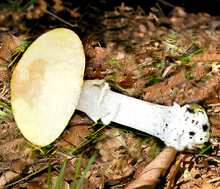| Amanita eliae | |
|---|---|

| |
| Scientific classification | |
| Domain: | Eukaryota |
| Kingdom: | Fungi |
| Division: | Basidiomycota |
| Class: | Agaricomycetes |
| Order: | Agaricales |
| Family: | Amanitaceae |
| Genus: | Amanita |
| Subgenus: | A. subg. Amanita |
| Species: | A. eliae
|
| Binomial name | |
| Amanita eliae Quél. (1872)
| |
| Amanita eliae | |
|---|---|
| Gills on hymenium | |
| Hymenium is free | |
| Stipe has a ring and volva | |
| Spore print is white | |
| Ecology is mycorrhizal | |
| Edibility is inedible | |
Amanita eliae is an inedible[1] species of fungi in the family of Amanitaceae found in Europe. It was described by Lucien Quélet in 1872.[2] Synonyms include A. eliae, A. godeyi, and A. cordae.
Description[edit]
Its cap is 8 to 10 centimetres (3 to 4 inches)[3] or 10 to 15 cm (4 to 6 in)[dubious ] in diameter[4] and 6 to 10 cm (2+1⁄2 to 4 in) across. It has a white volva.[1] Its warts correspond to easily removable, deep depressions in the cap of the species.[3] Its stem is around 8 to 12 cm (3 to 4+1⁄2 in) tall and has a diameter of 0.8 to 1.2 cm (1⁄2 to 1⁄2 in);[1] it is subcylindric and tapers upwards. The cap and stem have white flesh.[1][5] The stem is initially entirely white, but browns with age with a narrow bulb.[6] The stem ring is white.[1] Its stem is smooth and has white gills on the hymenium.[4] Its odour and taste are indistinct.[1][4]
Distribution and habitat[edit]
It is commonly found in Europe in the summer and autumn near coniferous and deciduous trees.[3][4]
References[edit]
- ^ a b c d e f Roger Phillips (12 September 2013). Mushrooms: A comprehensive guide to mushroom identification. Pan Macmillan. pp. 152–. ISBN 978-1-4472-6402-6.
- ^ "Amanita eliae". MycoBank. Retrieved 14 September 2015.
- ^ a b c Christian Deconchat; Jean-Marie Polèse (2002). Champignons: l'encyclopédie. Editions Artemis. p. 430. ISBN 978-2-84416-145-1. Retrieved 26 July 2012.
- ^ a b c d Michael Jordan (1 September 2004). The Encyclopedia of Fungi of Britain and Europe. frances lincoln ltd. pp. 196–. ISBN 978-0-7112-2379-0. Retrieved 25 July 2012.
- ^ Evangelina Pérez-Silva; Teófilo Herrera Suárez (1991). Iconografía de macromicetos de México: Amanita (in Galician). UNAM. pp. 52–. ISBN 978-968-36-1634-0. Retrieved 25 July 2012.
- ^ Giuseppe Pace (1 September 1998). Mushrooms of the world. Firefly Books. p. 217. ISBN 978-1-55209-212-5.
Further reading[edit]
- Evangelina Pérez-Silva; Teófilo Herrera Suárez (1991). Iconografía de macromicetos de México: Amanita. UNAM. pp. 52–. ISBN 978-968-36-1634-0. Retrieved 27 July 2012.
